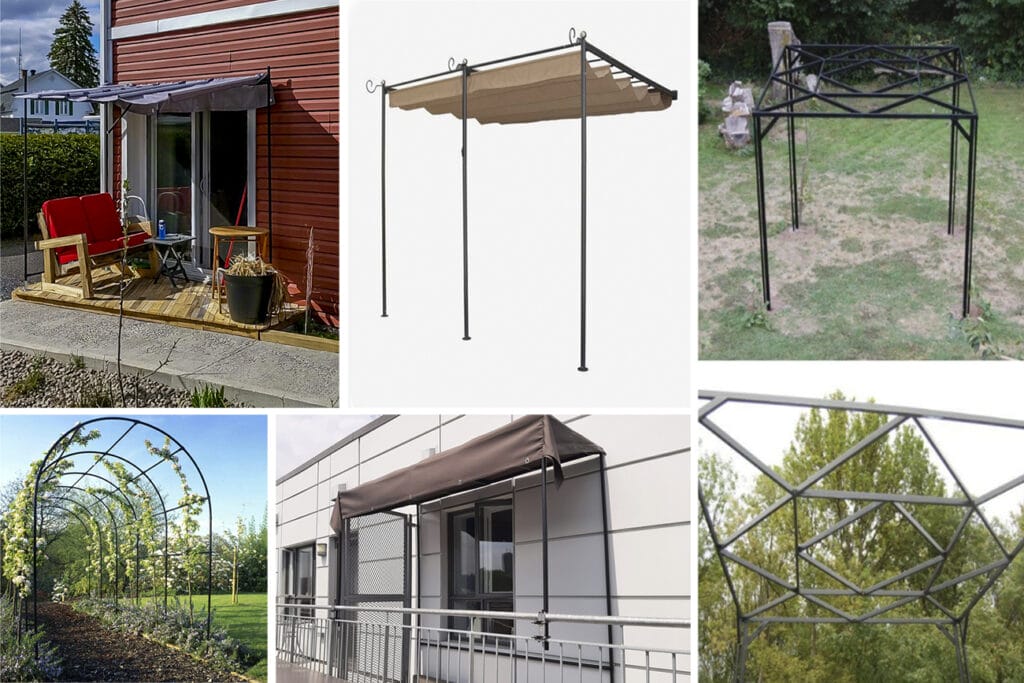Who doesn’t love the great outdoors? For many, it’s a place to relax, unwind, and soak up the sunshine and nature. Readers, this article is where your DIY outdoor canopy dreams become a reality. Imagine a serene afternoon, the gentle breeze rustling through the leaves, and your very own DIY canopy providing a cool space in your outdoor area. Before you enjoy the shade of your handcrafted retreat, there’s one crucial decision to make – selecting the perfect materials to build your DIY project.
We’re here to guide you through every step of the process, from choosing the material to installation and maintenance tips that will keep your canopy looking pristine for years to come!
And the best part? You can build your own low-cost canopy with tinktube, our eco-friendly DIY construction system that’s as easy on the wallet as it is on the environment. Let’s dive in and discover how to create your canopy without breaking the bank!
- From steel tubes to curtains: Materials and tools to build your DIY canopy
- Popular dimensions for outdoor canopies
- Step-by-Step guide to building your canopy
- Top 5 DIY outdoor canopy ideas
- Maintenance and care tips to keep in mind
- Backyard canopy fever: you now have all the tips for your home improvement project!
- DIY Pergola: 12 Low-Cost Ideas to Transform Your Outdoor Space
From steel tubes to curtains: Materials and tools to build your DIY canopy
Let’s start by rounding up the materials and tools you’ll need for your easy DIY canopy project. As mentioned earlier, in this post, we’ll highlight tinktube as your go-to construction system for building the frame of your canopy (you could always go for PVC pipe to build your DIY project, but we highly recommend using steel pipe, as it is more durable and sturdy). In addition to the material, you’ll need some basic tools like a measuring tape, a pipe cutter and a drill or a T-Handle wrench to get the job done.
tinktube offers 92″ steel pipes which you can use to build any kind of custom project, as those pipes are easy to cut. For any outdoor project, we highly recommend opting for painted tubes over galvanized, unpainted ones. Why? Because the paint serves as a protective barrier against humidity, ensuring that your outdoor projects withstand the elements and remain durable over time!
Canopy frame materials:
Tools:
Best types of fabric to build your outdoor canopy shade
When it comes to choosing the right fabric for your outdoor canopy, durability, UV protection, weather-resistance, costs and maintenance requirements are key.
Types of shade materials and comparison
Canvas:
Embrace timeless elegance with canvas, renowned for its durability and classic appeal. While it may demand a bit more care, its ability to withstand the elements and provide excellent UV protection makes it a top contender for your DIY canopy. Time-tested durability and classic charm make canvas a popular choice for outdoor enthusiasts.
Polyester:
Light on the wallet and easy to clean, polyester offers a practical solution for those seeking shade without breaking the bank. While it may not boast the same longevity as other materials, its UV resistance and low-maintenance appeal make it a worthy contender.
Polyethylene:
For the long haul, look no further than polyethylene. This powerhouse material boasts unbeatable UV protection and resilience against the elements, ensuring your canopy stands strong against nature’s toughest challenges. With superior UV protection and resilience against the elements, it’s the go-to option for DIYers looking to invest in a canopy that stands the test of time.
Shade cloth:
Versatility meets functionality with shade cloth, offering customizable shade levels and ample airflow to keep you cool on even the hottest of days. Whether your need curtains when you’re lounging poolside or hosting a backyard barbecue, shade cloth has you covered. Perfect for those who crave flexibility in their outdoor haven.
Online retailers like amazon, fabric.com and Home Depot offer a wide range of options to suit your needs and budget so you can build the perfect DIY canopy shade for you!
Popular dimensions for outdoor canopies
While the size of your canopy will ultimately depend on your specific needs and space constraints, there are some popular dimensions that you might want to consider. For a standard backyard setup, a canopy measuring around 10 x 10 feet is often sufficient to provide ample shade and coverage. Of course, you can always adjust the dimensions to fit your space, the furniture you want to use and the seating area you want to create—just be sure to take accurate measurements before getting started!
Step-by-Step guide to building your canopy
Now that you’ve gathered your materials and tools, it’s time to roll up your sleeves and get to work. Keep in mind that planning is key, so take some time to consider the size, location, and design of your canopy before diving in. Once you’ve got a solid plan in place, it’s time to start building the frame with tinktube.
Follow our detailed step-by-step instructions to ensure a sturdy and secure structure that will withstand the test of time.
Step 1: Measure and cut the tubes according to your design plan, using a hacksaw or pipe cutter. Ensure precise measurements to achieve the desired dimensions for your DIY outdoor canopy frame.
Step 2: Assemble the tinktube pieces according to your design, using connectors or fittings to join the tubes securely. Follow your plan closely to ensure proper alignment and stability of the frame.
Step 3: Secure the assembled frame to the ground or desired location using anchors, stakes, or concrete footings. Ensure that the frame is level and stable before proceeding to the next step.
Step 4: Measure, cut shade material and fix it to the frame. Here’s how to measure and cut like a pro:
- Take precise measurements of your canopy area, ensuring accuracy and accounting for any overhang or tensioning needs.
- Use chalk or a fabric marker to outline your cutting lines on the shade material, keeping them straight and true.
- Armed with sharp fabric scissors or a rotary cutter, carefully follow your marked lines, ensuring clean cuts and straight edges for a professional finish.
- Use a staple gun, heavy-duty thread, rope, or fabric clips to secure the fabric to the frame, making sure to pull it tight to prevent sagging. Trim any excess fabric for a neat finish.
And voila—your DIY outdoor canopy is starting to take shape!
Top 5 DIY outdoor canopy ideas
You may still be looking fo inspiration. Get creative with some customization ideas from romantic retreats to bohemian havens… The possibilities are endless when it comes to personalizing your outdoor canopy. Check out our top five ideas:
The romantic retreat: Create a canopy with round shapes and integrated lights for a soft and dreamy ambiance.
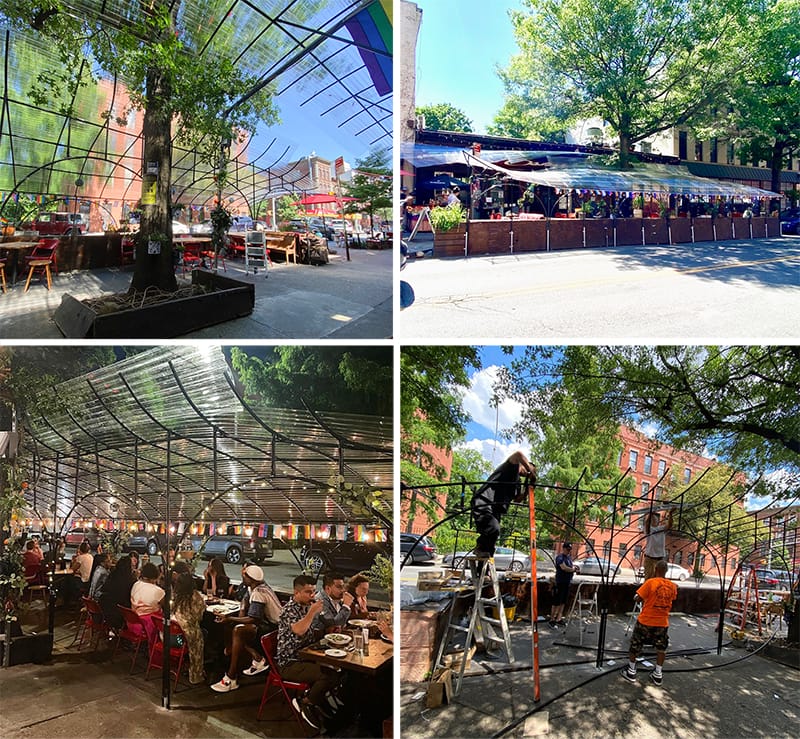
The bohemian haven: Add colorful drapes and string lights for a whimsical boho vibe.
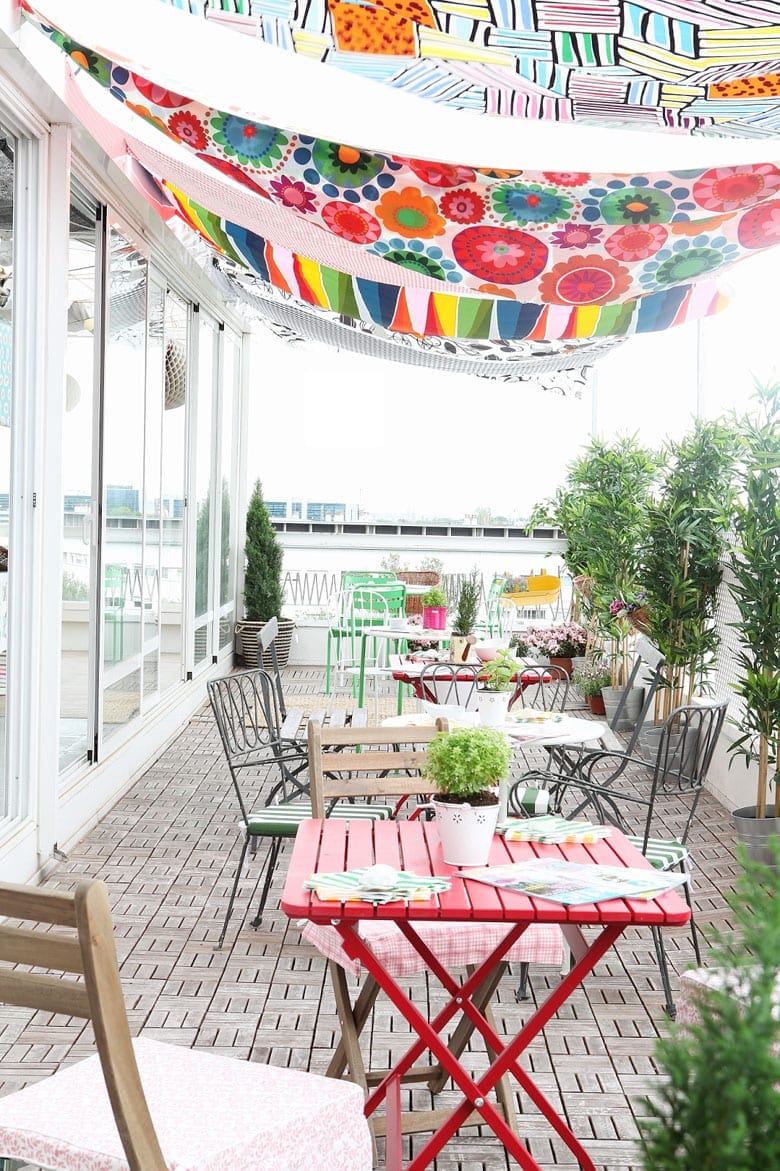
The minimalist shade: Keep it sleek and modern with a minimalist design using neutral colors.
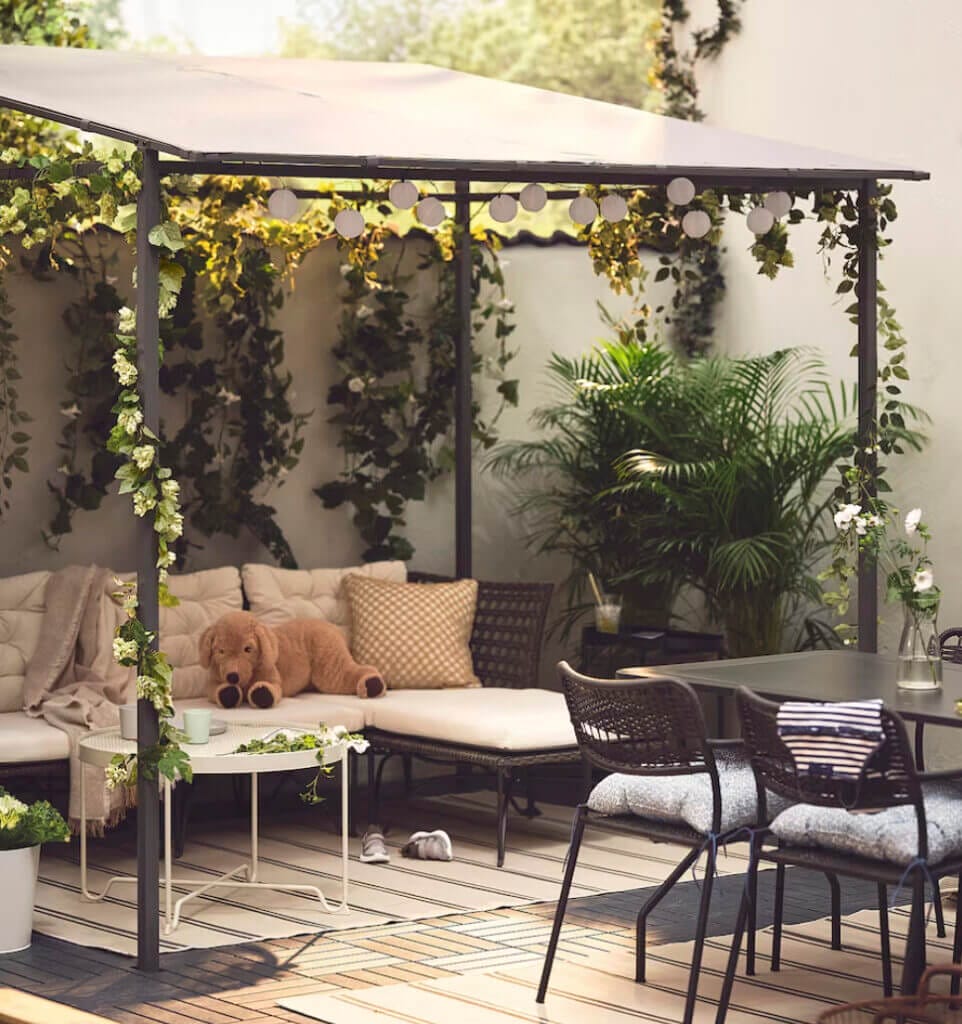
The garden oasis: Incorporate planters into your DIY outdoor canopy frame and greenery into your canopy for a lush, tropical feel!
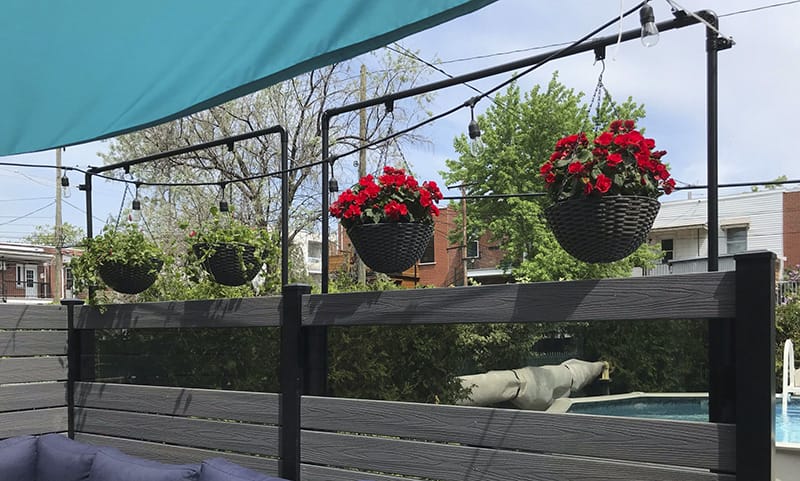
The beachside shelter: Create a portable and adjustable canopy with lightweight materials for beach trips and outdoor adventures.
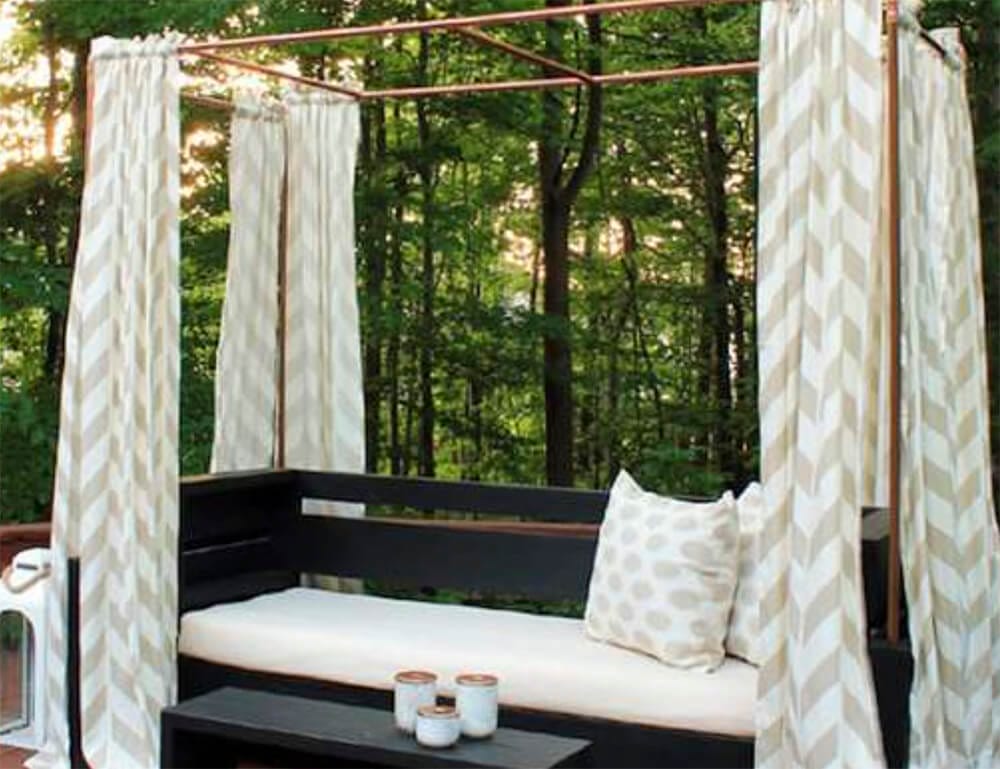
Maintenance and care tips to keep in mind
Last but not least, let’s talk about maintenance and care for your DIY outdoor canopy.
- Keep it clean: Regularly remove dirt, debris, and stains from your shade material to maintain its appearance and prolong its lifespan. Use a mild soap and water solution to clean the fabric.
- Check for damage: Inspect your canopy for signs of wear and tear, such as tears or fraying edges, and address them promptly to prevent further damage. Check the frame for any loose or damaged components.
- Store with care: During periods of disuse or inclement weather, store your shade material in a cool, dry place to protect it from sun damage and prolong its longevity.
Backyard canopy fever: you now have all the tips for your home improvement project!
And there you have it—a complete guide to building your own low-cost outdoor canopy with tinktube. From materials and tools to customization ideas and maintenance tips, we’ve covered everything you need to know to create the outdoor sanctuary of your dreams. So what are you waiting for? Grab your tinktube and get started on your DIY outdoor canopy project today!
Do you have questions or want to share your own canopy creations? We want to hear from you! Drop us a comment below and let’s chat all things tinktube. And don’t forget to check out our full range of tinktube products and resources to fuel your DIY dreams. Happy building!
DIY Pergola: 12 Low-Cost Ideas to Transform Your Outdoor Space
Each one of the ideas in this post is guaranteed to spark your creativity. From whimsical designs to clever hacks, we’re here to prove that DIY pergolas can be a wild, wacky, and wallet-friendly adventure!
Arbor made by Ian
Ian built an arbor for his frontyard path.
